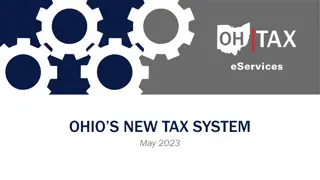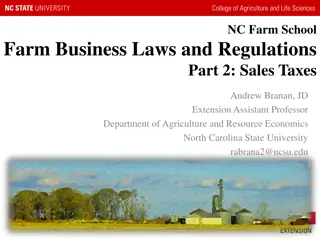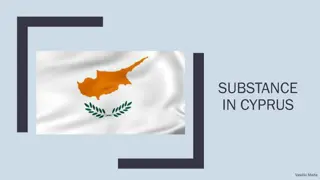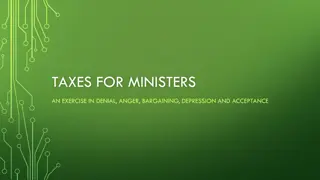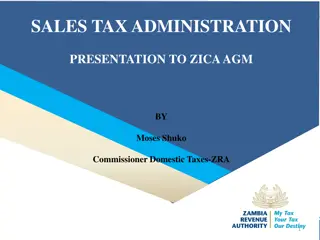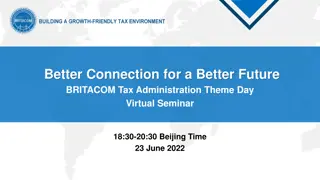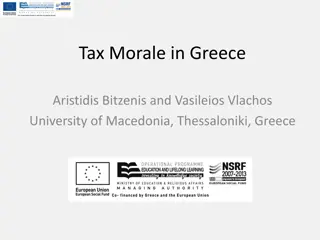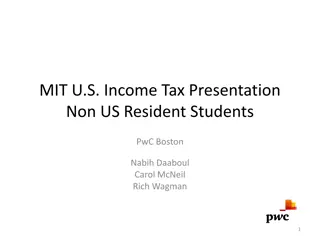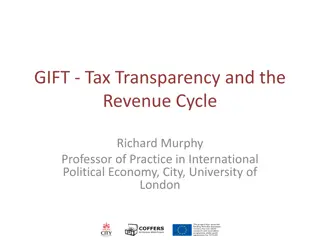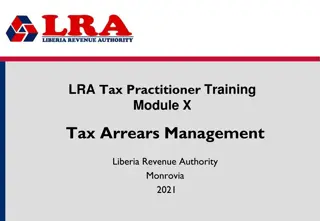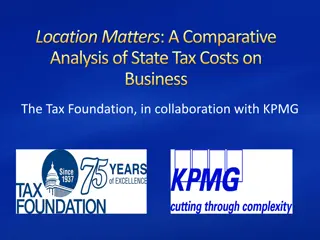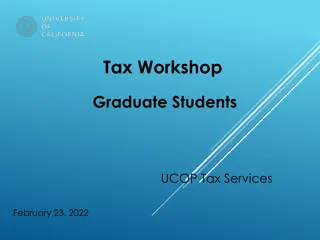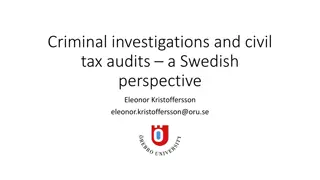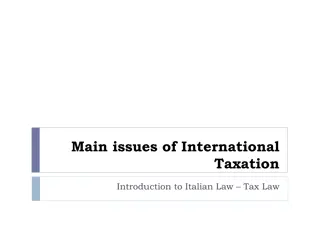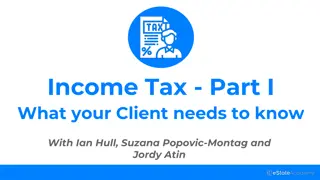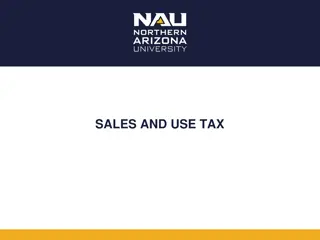2023 Tax Legislation Overview
The presentation by National Treasury and SARS outlines the 2023 tax bills and legislative process. It covers adjustments in values, updates on tax rates, implementation of carbon tax, incentive reviews, and more. The content details various tax bills, including the Rates Bill, Revenue Laws Amendment Bill, and Tax Administration Laws Amendment Bill, addressing taxation across different sectors like business, finance, and international taxes.
Download Presentation

Please find below an Image/Link to download the presentation.
The content on the website is provided AS IS for your information and personal use only. It may not be sold, licensed, or shared on other websites without obtaining consent from the author. Download presentation by click this link. If you encounter any issues during the download, it is possible that the publisher has removed the file from their server.
E N D
Presentation Transcript
PRESENTED BY: National Treasury & SARS 2023 TAX BILLS Title: 2023 Tax Bills Date: 21 November 2023 Presentation to the Select Committee on Finance
2 2023 tax process summary Adjustment of values Two pots reform Rates bill (immediate effect) 2 initial sets Urgent: Energy incentives Complex: Two pots tax matters and Pension Fund amendments TLAB Implementation of Carbon tax Technical updates New policies Incentive reviews TALAB Multi-year projects Budget announcements Draft legislation
3 CONTENTS Overview of the annual tax legislative process General business taxes Taxation of financial institutions and products 2023 Rates and Monetary Amounts and Amendment of Revenue Laws Bill (Rates Bill) Tax Incentives Rates of normal tax International Tax Excise duties on alcohol & tobacco Value Added Tax Postponement of the effective date of an increase in the health promotion levy Carbon Tax Customs & Excise Act: Vaping 2023 Revenue Laws Amendment Bill 2023 Tax Administration Laws Amendment Bill Two Pot retirement system Customs & Excise Act 2023 Taxation Laws Amendment Bill (TLAB) Value Added Tax Act Employment, Individuals and Savings Tax Administration Act
4 Overview of the 2023 tax process 2023 Rates and Monetary Amounts and Amendment of Revenue Laws Bill (Rates Bill) Announcement of tax legislative proposals in the 2023 Budget Review. The 2023 Draft Rates Bill was first published on Budget Day (22 February 2023) and published again on 30 July 2023, in order to solicit comments on the tax proposals contained therein. The 2023 Rates Bill contains tax announcements made in the 2023 Budget, dealing with changes in rates and monetary thresholds to the personal income tax tables, and increases of the excise duties on alcohol and tobacco.
5 Overview of the 2023 tax process 2023 Revenue Laws Amendment Bill The National Treasury and SARS published for public comment the revised 2023 Draft Revenue Laws Amendment Bill on 9 June 2023. 2023 Taxation Laws Amendment Bill (TLAB) and 2023 Tax Administration Laws Amendment Bill (TALAB) The 2023 Draft TLAB and TALAB were published for public comment on 30 July 2023. These draft bills contain the remainder of the tax announcements made in Chapter 4 and Annexure C of the 2022 Budget Review, which are legislatively more complicated and require greater consultation with the public.
6 Overview of the 2023 tax legislative process Due to constitutional requirements, the tax bills are split into two separate bills, i.e., money bills in terms of section 77 of the Constitution dealing with national taxes, levies, duties and surcharges (Rates Bill, Revenue Laws Amendment Bill and TLAB) and ordinary bills in terms of section 75 of the Constitution, dealing with administration issues i.e. TALAB. The draft TLAB and draft TALAB have been published for public comments on 30 July 2023 and the public has been granted a month-long period to submit comments in writing. The closing date for public comments is 31 August 2023. SCoF/ SeCoF normally convenes public hearings on the draft tax bills prior to their formal introduction in Parliament. NT and SARS engaged stakeholders that submitted comments through workshops that were held on 6-8 September 2023. NT and SARS presented a response document to the SCoF on 25 October. The final Bills were tabled by the Minister of Finance during the MTBPS.
7 ADJUSTMENTS IN THE 2023 RATES BILL
8 Inflation-related adjustments to tax tables Tax tables, rebates, Medical tax credits: All adjusted by estimated inflation of 4.9% Table 4.5 Personal income tax rates and bracket adjustments 2022/23 2023/24 Table 4.6 Estimates of individuals and taxable income, 2023/24 Taxable bracket Registered individuals Taxable Income tax Income tax relief Income tax Taxable income (R) Rates of tax Taxable income (R) Rates of tax R billion income R billion payable R billion after proposals R billion payable R thousand Number % % % % % R0 - R226 000 18% of each R1 R0 - R237 100 18% of each R1 R0 - R961 R96 - R150 7,545,020 292.2 R226 001 - R353 100 R40 680 + 26% of the amount R237 101 - R370 500 R42 678 + 26% of the amount 1,528,990 21.5 182.0 6.2 14.9 2.3 -1.1 5.7 13.8 2.2 above R226 000 above R237 100 R150 - R250 1,505,950 21.1 292.0 9.9 22.0 3.3 -1.4 7.3 20.6 3.2 R353 101 - R488 700 R73 726 + 31% of the amount R370 501 - R512 800 R77 362 + 31% of the amount R250 - R350 1,248,123 17.5 370.1 12.5 48.5 7.4 -2.2 11.3 46.3 7.2 above R353 100 above R370 500 R488 701 - R641 400 R115 762 + 36% of the amount R512 801 - R673 000 R121 475 + 36% of the amount R350 - R500 1,233,846 17.3 516.3 17.4 89.5 13.6 -3.3 16.7 86.2 13.5 above R488 700 above R512 800 R500 - R750 842,653 11.8 506.4 17.1 113.9 17.3 -3.6 18.3 110.3 17.2 R641 401 - R817 600 R170 734 + 39% of the amount R673 001 - R857 900 R179 147 + 39% of the amount R750 - R1 000 354,263 5.0 305.1 10.3 84.3 12.8 -2.2 11.2 82.1 12.8 above R641 400 above R673 000 R1 000 - R1 500 244,586 3.4 294.3 9.9 92.8 14.1 -2.5 12.8 90.3 14.1 R817 601 - R1 731 600 R239 452 + 41% of the amount R857 901 - R1 817 000 R251 258 + 41% of the amount R1 500 + 163,702 2.3 493.6 16.7 193.9 29.4 -3.3 16.7 190.6 29.8 above R817 600 above R857 900 Total 7,122,113 100.0 2,959.9 100.0 660.0 100.0 -19.7 100.0 640.3 100.0 R1 731 601 and above R614 192 + 45% of the amount R1 817 001 and above R644 489 + 45% of the amount above R1 731 600 above R1 817 000 Grand total 14,667,133 3,252.1 660.0 -19.7 640.3 Rebates Rebates 1. Registered individuals with taxable income below the income-tax threshold Primary R16 425 Primary R17 235 Source: National Treasury Secondary R9 000 Secondary R9 444 Tertiary R2 997 Tertiary R3 145 Tax threshold Tax threshold Below age 65 R91 250 Below age 65 R95 750 Age 65 and over R141 250 Age 65 and over R148 217 Age 75 and over R157 900 Age 75 and over R165 689 Source: National Treasury Medical tax credits increase from R347 to R364 per month for the first two members, and from R234 to R246 per month for additional members.
9 Inflation-related adjustments to tax tables Retirement tables and transfer duties increased by 10% Retirement tables were last adjusted in 2014, transfer duties in 2020. Between 2014-2020 we didn t offer full relief to PIT tax brackets either Table 4.8 Personal income tax rates: Retirement fund lump sum benefits 2022/23 2023/24 Taxable income (R) Taxable income (R) Rates of tax 0% of taxable income Rates of tax 0% of taxable income R0 - R500 000 R0 - R550 000 Table 4.7 Transfer duty rate adjustments R500 001 - R700 000 18% of taxable income R550 001 - R770 000 18% of taxable income 2022/23 2023/24 above R500 000 above R550 000 Property value (R) R0 - R1 000 000 Rates of tax 0% of property value Property value (R) R0 - R1 100 000 Rates of tax 0% of property value R700 001 - R1 050 000 R56 700 + 27% of taxable income R770 001 - R1 155 000 R39 600 + 27% of taxable income R1 000 001 - R1 375 000 3% of property value R1 100 001 - R1 512 500 3% of property value above R700 000 above R770 000 above R1 000 000 above R1 100 000 R1 050 001 and above R141 750 + 36% of taxable income R1 155 001 and above R143 550 + 36% of taxable income R1 375 001 - R1 925 000 R11 250 + 6% of property value R1 512 501 - R2 117 500 R12 375 + 6% of property value above R1 050 000 above R1 155 000 above R1 375 000 above R1 512 500 Source: National Treasury R1 925 001 - R2 475 000 R44 250 + 8% of property value R2 117 501 - R2 722 500 R48 675 + 8% of property value above R1 925 000 above R2 117 500 Table 4.9 Personal income tax rates: Retirement fund lump sum withdrawal benefits 2022/23 R2 475 001 - R11 000 000 R88 250 + 11% of property value R2 722 501 - R12 100 000 R97 075 + 11% of property value 2023/24 above R2 475 000 above R2 722 500 Taxable income (R) Taxable income (R) Rates of tax 0% of taxable income Rates of tax 0% of taxable income R11 000 001 and above R1 026 000 + 13% of property value R12 100 001 and above R1 128 600 + 13% of property value R0 - R25 000 R0 - R27 500 R25 001 - R660 000 18% of taxable income R27 501 - R726 000 18% of taxable income above R11 000 000 above R12 100 000 above R25 000 above R27 500 Source: National Treasury R660 001 - R990 000 R114 300 + 27% of taxable income R726 001 - R1 089 000 R125 730 + 27% of taxable income above R660 000 above R726 000 R990 001 and above R203 400 + 36% of taxable income R1 089 001 and above R223 740 + 36% of taxable income above R990 000 above R1 089 000 Source: National Treasury
10 General inflationary increase in the excise duties on alcohol and tobacco Government has a guideline on (or regarding) direct excise duty policy where duty should be 11, 23 and 36 per cent of weighted average retail price for wine, beer and spirits and 40 per cent of price of the most popular brand for cigarettes. In 2023, Government proposes to increase excise duties on alcohol and tobacco in line with expected inflation of 4.9 per cent.
11 The increase to the health promotion levy was delayed for an additional two years The 2022 Budget stated that the HPL would be increased by inflation at 4.5 per cent to 2.31 cents per gram from 1 April 2022 On 1 April 2022, the Minister of Finance released a media statement to delay the implementation of the increase on the HPL to 1 April 2023 However, in the February 2023 Budget, the Minister further announced that there will be no increase in the HPL in 2023/24 and 2024/25. A discussion paper on the HPL Review will still be published for consultation on proposals to extend the levy to pure fruit juices and lower the 4-gram threshold.
12 2023 REVENUE LAWS AMENDMENT BILL: TWO POT RETIREMENT SYSTEM
13 Two pots retirement system: Policy background South Africa has different retirement fund vehicles available to individuals, including pension funds, provident funds, retirement annuity funds, pension preservation funds and provident preservation funds. Historically, each of these funds had a different tax treatment for contributions, alongside different rules for withdrawals. Since 2012, the South African retirement fund regime has been undergoing fundamental reforms These reforms include amendments to harmonise the tax treatment of contributions to the different types of funds, measures to increase preservation (both before retirement and at retirement), and reforms to lower charges and improve defaults, governance and market conduct. Many of these reforms have been implemented, including: The harmonisation of the tax treatment of contributions to funds, which was implemented with effect from 1 March 2016 The preservation of provident funds at retirement through annuitisation, effective from 1 March 2021.
14 Two pots retirement system: Policy background There are two primary concerns regarding the current design of the retirement system. The first concern is the lack of preservation before retirement. For pension funds and provident funds, this access is dependent on an employee terminating employment. Individuals can then access their funds, in full, when changing or leaving a job. The second concern is the lack of access even in cases of emergency by some households that are in financial distress that have assets within their retirement funds. In an attempt to address the above-mentioned concerns, Government therefore proposes a further reform to the retirement saving regime. This reform will see the introduction of the so called two-pots retirement system. The two-pots system seeks to retain the current principle of exempting contributions and growth thereon while taxing withdrawals of benefits (i.e. the EET system). The EET system is retained as a means of, inter alia, ensuring that income is only taxed once, retaining the logic applied in the 2016 retirement reform which served to harmonise the tax treatment across various retirement funds, and minimising the complexity that comes with valuing growth on contributions.
15 Two pots retirement system: Policy background Members of retirement funds are allowed a deduction for amounts contributed (be it by themselves or their employer on their behalf) to retirement funds. The deduction applicable under the current retirement regime will apply under the two-pots regime (i.e. a deduction for contributions, limited to the lesser of R350 000 or 27,5% of the higher of taxable income or remuneration). Section 37D deductions as contained in the Pension Funds Act, 1956, will be permissible against the vestedcomponent and retirementcomponent . Employer contributions made on behalf of employees are be treated as a taxable fringe benefit in the employee s hands. Arrear contributions that relate to a pre-implementation period will be allocated to the respective pre-implementation period and will be subject to the rules applicable under the current retirement regime. Arrear contributions that relate to a post-implementation period will be allocated to the respective savingscomponent and retirementcomponent .
16 Two pots retirement system: Policy background It is proposed that the regime makes provision for the creation of seed capital. This will make provision for immediate access to the allowable balance in the retirement fund on implementation date of the two-pots retirement system. Seed capital refers to the starting balance in the savingscomponent on 1 March 2025, which should be available to the member of the retirement fund for withdrawal on or after implementation date of the two-pots retirement system. This starting balance is to be provided in the savingscomponent after reallocation from the vestedcomponent . In order to limit the adverse impact on liquidity, it is proposed that seed capital should be calculated as the lesser of ten per cent of the vestedcomponent and R30 000. This is intended to not erode the retirement benefit but at the same time enable pre-retirement access to the benefits.
17 Two pots retirement system: Savings component In accordance with this new regime, retirement funds will on or after 1 March 2025, be required to create a component known as the savings component, which will be housed within the current retirement fund. Individuals will be required to contribute an amount of one-third of the total individual retirement fund contributions to the savingscomponent . The assets in the savingscomponent will be available for withdrawal before retirement. The ability to access amounts from the savingscomponent will be provided without the member having to cease employment or having to resign or retire from their respective fund. A member will be allowed to make a single withdrawal within a year of assessment. The minimum withdrawal amount is R2 000.
18 Two pots retirement system: Savings component In the event that a member resigns from employment and such member has already made use of their single withdrawal during that tax year, an additional withdrawal will be allowed provided the member s gross interest in their savingscomponent is less than R2 000. The ability to withdraw from the savingscomponent will be applicable on a per fund or per contract basis. Withdrawals from the savingscomponent will be added to the individual s taxable income and will be taxed at their marginal tax rates. In the event that a member dies, their beneficiary can opt to receive the benefit in the savingscomponent as either a lumpsum or as a transfer to the retirementcomponent of their retirement fund and eventually receive an annuity.
19 Two pots retirement system: Retirement component Retirement funds will on or after 1 March 2025, be required to create another component known as the retirement component, which will be housed within the current retirement fund. Individuals will be required to contribute an amount of two-thirds of the total individual retirement fund contributions to the retirementcomponent . The assets in the retirementcomponent will be required to be preserved until retirement (i.e. withdrawals from this component can only be accessed by the member upon retirement per the fund rules). Once a member has reached retirement age and retires, the retirementcomponent is to be paid in the form of an annuity (including a living annuity). The current de-minimis as relates to the commutation of annuities (currently R165 000) will apply to annuities from this component. The ability to commute an annuity will be determined with reference to the member s interests in their vestedcomponent and retirementcomponent , and will be determined on a per fund basis.
20 Two pots retirement system: Retirement component Withdrawals from the retirementcomponent are accessible as a lump sum when an individual ceases to be a tax resident of South Africa. The payment of the said lump sums is however subject to the 3-year rule that under the current regime applies to members of a retirement annuity fund, pension preservation fund or provident preservation fund.
21 Two pots retirement system: Vested component Retirement funds will on or after 1 March 2025, be required to create another component known as the vested component . Retirement funds will be required to value a member s retirement interest on the date immediately prior to the implementation date, which is 1 March 2025, as these amounts will be subject to the current retirement regime (i.e., vested and non-vested rights arising as a result of the annuitisation reform which came into effect from 1 March 2021 will be retained).
22 Two pots retirement system: Vested component Once the regime comes into effect, members will no longer be able to make contributions to their vestedcomponent . This will however not apply to members of a provident fund who were 55 years or older on 1 March 2021. These members have the ability to continue making contributions into their vestedcomponent and this will apply until they either retire from or leave the fund they were a member of on 1 March 2021. Should they choose to keep contributing to their vestedcomponent their full contribution will be allocated to the vestedcomponent . Continued contribution to their vestedcomponent means they will not be able to contribute to the savings component and retirementcomponent . Provident fund members who were 55 years and older on 1 March 2021 are however not precluded from participation in the two-pots regime, should they elect to participate in the new regime they will no longer be able to continue contributing to their vestedcomponent (i.e. their contributions will be split between the savings component and retirementcomponent as is applicable to other retirement fund members).
23 Two pots retirement system: Vested component Amounts contained in the vestedcomponent will be subject to the current retirement regime. This includes, inter alia, the ability to make once-off withdrawals from preservation funds, the ability to access pension and provident funds upon resignation, the continued protection of vested rights arising as a result of the annuitisation reform, and the mandatory annuitisation of two-thirds of a members retirement interest with effect from 1 March 2021. Withdrawals from the vestedcomponent are accessible as a lump sum when an individual emigrates from South Africa and ceases to be a tax resident. The payment of the said lump sums is however subject to the 3-year rule that under the current regime applies to members of a retirement annuity fund, pension preservation fund or provident preservation fund.
24 Two pots retirement system: Defined benefit funds It is proposed that provision should be made for the inclusion of defined benefit funds in the two-pots retirement regime. Since contributions by a member to the defined benefit fund are based on a defined formula, without reference to contributions and investment performance: defined benefit funds will be required to calculate the one-third contributions to the savingscomponent with reference to one-third of the member s pensionable service and the two-thirds contributions to the retirementcomponent with reference to two-thirds of the member s pensionable service with effect from 1 March 2025. Seed capital is to be calculated in the same manner as other funds and can be accommodated with a past service adjustment.
25 Two pots retirement system: Legacy retirement annuity funds In is proposed that legacy retirement annuity funds be excluded from the provisions of the two-pot retirement system, as the inclusion of the legacy retirement annuity fund policies in the two-pot retirement system would require a re-design of these historically acquired legacy retirement annuity fund policies. It is however important to note that this exemption is not a blanket exemption, and will be applicable to legacy funds with the following features: Pre-universal life policies or conventional policies with or without profits; Universal life policies with life or lumpsum disability cover; and Reversionary bonus or universal life policies as defined or referenced in the insurance legislation. To ensure that the exemption as relates to legacy polies applies only to legacy policies entered into before the formulation of the two-pots regime, it is proposed that the exemption applies to legacy policies entered into before 1 March 2025. The legacy fund must have submitted a signed declaration to the Financial Sector Conduct Authority (FSCA) stating that they meet the above criteria. The FSCA may conduct verification that funds meet the exemption criteria.
26 Two pots retirement system: Transferability of funds Members will be allowed to make the following intra-fund transfers at any time they wish, these transfers will be treated as tax free transfers: From their savingscomponent to their retirementcomponent ; and From their vestedcomponent to their retirementcomponent . Inter-fund transfers are only permissible when a member resigns or retires from their respective fund. Should a member choose to make an inter-fund transfer all components will need to be transferred to the transferee fund (i.e. the member is not able to transfer only one component while leaving the other components behind).
27 Two pots retirement system: Transferability of funds The below inter-fund transfers will be permissible as tax-free transfers (provided that the transfer is a transfer of all relevant components): From the transferor fund s savingcomponent to the transferee fund s savingcomponent ; From the transferor fund s savingcomponent to the transferee fund s retirementcomponent ; From the transferor fund s vestedcomponent to the transferee fund s vestedcomponent ; From the transferor fund s vestedcomponent to the transferee fund s retirementcomponent ; From the transferor fund s retirementcomponent to the transferee fund s retirementcomponent ; The ability to effect both inter and intra fund transfers will be subject to the fund obtaining a tax directive.
28 CHANGES AFTER PUBLICATION OF DRAFT RLAB
29 Two pots retirement system Postponement of the effective date Change of the seeding capital from R 25 000 to R 30 000 Provident fund members who were 55 years and older as at 1 March 2021 shall, by default, be excluded from the two- pots regime with the opportunity to opt-in should they choose. The proposed definition for legacy retirement annuity funds as contained in the draft legislation was amended to include features unique to a legacy policy, i.e., universal life or pre-universal life construct
30 2023 TLAB: INDIVIDUALS, EMPLOYMENT AND SAVINGS
31 Basic features of new energy tax incentives Solar energy credit for individuals Enhanced renewable energy deduction for businesses Why do we propose these? Encourage individuals to invest in clean energy generation to supplement energy supply Temporarily enhancement of existing renewable energy tax incentive encourage rapid private investment to alleviate this energy crisis Who can claim? Individuals who pay income tax Businesses who are registered for corporate income tax and sole proprietors who calculate business income for their personal income tax What is the value of the incentive? 25% of the value of the cost of solar PV panels, up to a maximum of R15000 per individual Deduct 125% of the cost of assets that produce renewable energy
32 How can it be claimed? Solar energy credit for individuals Enhanced renewable energy deduction for businesses What requirements? Only new and unused solar PV panels qualify Minimum capacity of 275W per panel Installed at a residence used mainly for domestic purposes Connected to mains distribution (DB) Acquired and brought into use between 1 March 2023 and 29 February 2024 New and unused assets used in the generation of electricity from eligible renewable energy sources Must be owned or acquired by that taxpayer Brought into use for the first time between 1 March 2023 and 1 March 2025 What documentation is required? An invoice An electrical Certificate of Compliance An invoice Any special provisions? If the panels are sold before 1 March 2025 the taxpayer will have to pay back the credit. Not available for panels that were claimed under business incentive If the assets are sold before 1 March 2026, 125% of of the amount recovered or recouped will be included in the taxpayer s income
33 Solar energy tax credit (Clauses 2 and 28 the TLAB: New section 6C and section 25 of the Income Tax Act) The tax system does not generally allow for deductions in respect of personal consumption, for example, expenses incurred in respect of a motor vehicle used for private purposes or expenses incurred in respect of a salary paid to a domestic worker. However, in certain circumstances, either for purposes of encouraging individuals to save for retirement or for philanthropic purposes, or in instances where the expenditure is directly linked to employment income, the Act allows individuals who derive employment income, and or passive income, a credit or deduction in respect of a limited number of expenses. In response to the severe energy crisis currently being experienced by the country, Government is proposing various policy measures to the renewable energy mix to improve energy generation and reduce pressure on the electricity grid. To encourage households to invest in clean electricity generation capacity, which can supplement electricity supply, Government proposed a rooftop solar tax incentive for individuals who invest in solar photovoltaic (PV) panels.
34 Solar energy tax credit (Clauses 2 and 28 the Draft TLAB: New section 6C and section 25 of the Income Tax Act) It is proposed that individuals who are liable for personal income tax be granted a solar energy tax credit, which will apply as follows: To new and unused solar PV panels brought into use for the first time on or after 1 March 2023 and before 1 March 2024, with a generation capacity of not less than 275W each. The solar PV panels should form part of a system that is connected to the distribution board of a residence that is mainly used for domestic purposes and in respect of which an electrical certificate of compliance is issued. The credit will only be available for a 1 year period. The allowable credit is calculated as 25 per cent of the cost of the solar PV panels, up to a maximum of R15 000. The credit is available to any individual who owns, rents or occupies a residence to which the panels are affixed, and has also incurred the costs of the panels. To ensure that there is no duplication of tax incentives in respect of a solar PV panel, the energy tax credit shall not be allowed for a solar PV panel in respect of which an allowance is granted in terms of section 12B or 12BA of the Act.
35 2023 TLAB: GENERAL BUSINESS TAX
36 Reviewing the principles of practice note 31 of 1994 (Clause 14 of the TLAB: New section 11G of the Income Tax Act) In 1994, Practice Note 31 of 1994, titled Interest paid on moneys borrowed was issued. On 16 November 2022, the South African Revenue Service (SARS) issued a notice informing the public of the intention to withdraw this practice note, with effect from years of assessment starting on or after 1 March 2023 due to the increasing abuse of the tax deduction concession provided for in Practice Note 31. After reviewing the public comments received on the withdrawal of the practice notes, government considered the impact of the proposed withdrawal and proposed changes to tax legislation to accommodate legitimate transactions affected by such withdrawal. Ordinarily, deductions are allowed where the requirements of the general deduction formula is met (i.e. trade requirement, income production requirement and revenue nature requirement). Where one of these is not satisfied and a deduction is justified and intended, specific rules are introduced (for example section 24O that allows for the deduction of interest in respect of share acquisitions in qualifying operating companies). As such, the practice under Practice Note 31 was limited to minimise the adverse effect of withdrawal on companies and proposed legislation was included in the Draft TLAB that was published for public comment to allow for a deduction of interest where one company within a group of companies raises debt that it on-lends to a fellow group company that uses the debt for income producing purposes within its trade.
37 CHANGES AFTER PUBLICATION OF DRAFT TLAB
38 Reviewing the principles of practice note 31 of 1994 However, during public consultations stakeholders made submission on the negative impact of the narrow concession contained in the Draft TLAB that was published for public comment and, as a result, the concession contained in section 11G was expanded to apply to any person that incurs interest expenditure in the production of interest income (limited to said interest income) without regard to any shareholding threshold of any back-to-back lending arrangement. To allow for further engagements during the 2024 legislative cycle, the proposed concession will come into operation on 1 January 2025.
39 Clarification of the interest limitation rules (Clause 26 of the TLAB: Section 23M of the Income Tax Act) In 2021, changes were made to the Act as part of the corporate income tax package to broaden the tax base and reduce the headline corporate income tax rate in a revenue neutral manner. One of these measures included strengthening the rules dealing with the limitation of interest deductions for debts owed to certain persons not subject to tax in section 23M of the Act. Government received requests for further clarity on these rules and the 2023 Budget outlined a number of issues that would be considered. These include, for example, how assessed losses are taken into account in the definition of adjusted taxable income , whether a definition for creditor is required, and if the definition of controlling relationship is appropriate. It is proposed that legislation be amended to align with the policy intent of adding only the balance of assessed losses from prior years to taxable income. The starting point for adjusted taxable income should be taxable income calculated before applying the section and setting off any assessed loss. It is proposed that the definition of the term "creditor" be included in section 23M to clarify that any person to whom interest is payable is considered a creditor for the purpose of the section.
40 Clarification of the interest limitation rules (Clause 24 of the TLAB: Section 23M of the Income Tax Act) To address the uncertainty arising from the treatment of exchange gains and losses, it is proposed that exchange gains be classified as interest received or accrued for the purposes of section 23M of the Act. Government has considered how the definition of controllingrelationship in section 23M(1) of the Act and the provisions of 23M(2) of the Act interact in light of the intended policy outcome, and proposes to retain the current stance. Government proposes that the legislation be clarified to make it clear that the proviso to section 23M(2) is only applicable to interest when withholding tax on interest is payable on the interest. Government proposes that section 23M(6) of the Act be amended to extend the exemption for lending institutions to also apply to South African banks.
41 2023 TLAB: TAXATION OF FINANCIAL INSTITUTIONS AND PRODUCTS
42 Tax treatment of deposit insurance (Clause 9 of the TLAB: Section 10 of the Income Tax Act) In 2020, Government announced the establishment of a deposit insurance scheme to protect depositors in the event of a bank failure, which in turn will contribute to the stability of the South African financial system. It was also envisaged that each bank will make stipulated contributions to the scheme. In 2022, Parliament passed legislation dealing with the deposit insurance scheme. This deposit insurance scheme is a subsidiary of the SARB, making it a separate legal entity with its own legislative framework and governance requirements. The SARB is responsible for the collection from the banks and administration, on behalf of the Corporation, of the deposit insurance levy referred to in sections 9 and 12 of the Financial Sector and Deposit Insurance Levies Act, No. 11 of 2022 read with Schedule 6 to that Act and section 166BC of the Financial Sector Regulation Act of 2017, to provide for the funding of the operations of the Corporation and the administration of the Fund. To provide a rule for the tax treatment of the Corporation for Deposit Insurance, it is proposed that the receipts and accruals of the Corporation for Deposit Insurance be exempt from income tax.
43 CHANGES AFTER PUBLICATION OF DRAFT TLAB
44 Tax treatment of deposit insurance VAT Act was also amended to cater for the Corporation for Deposit Insurance.
45 2023 TLAB: INTERNATIONAL TAX
46 Clarifying the foreign business establishment exemption for controlled foreign companies (Clause 7 of the Published Bill: Section 9D of the Income Tax Act) The Act contains anti-avoidance rules in section 9D aimed at taxing South Africa residents on an amount equal to the net income of a controlled foreign company (CFC). In order to strike a balance between protecting the South African tax base and the need for South African multinationals to be competitive offshore, the South African CFC rules contains various exemptions of certain types of income. For example, amounts that are attributable to a foreign business establishment (FBE) of a CFC, as defined in section 9D, are excluded from the net income of the CFC. A foreign business establishment must consist of a fixed place of business located outside South Africa that is used or will continue to be for the carrying on of business of the CFC for a period of at least 1 year. In addition, a FBE must satisfy additional requirements relating to the nature of the business, for example, the business must have a minimum specified structure (e.g. an office), the fixed place of business should be suitably staffed with on- site managerial and operational employees of that CFC, the fixed place of business should be suitably equipped and have suitable facilities for conducting the primary operations of the business.
47 Clarifying the foreign business establishment exemption for controlled foreign companies (Clause 7 of the Published TLAB: Section 9D of the Income Tax Act) Furthermore, the definition of a foreign business establishment allows for structures, employees, equipment and facilities of another company to be taken into account if the structures, employees, equipment and facilities are located in the same country as the fixed place of business of the CFC, the other company is subject to tax in the country in which the CFC s place of business is located and the other company forms part of the same group of companies as the CFC. It has come to Government s attention that some taxpayers are retaining certain management functions but outsourcing other important functions for which the CFC is also being compensated by its clients. The location of the primary operations , is vital in determining whether a company meets the definition of an FBE as defined in the Act. It is proposed that all important functions for which a CFC is compensated should be performed either by the CFC or by another CFC in the same group of companies that is located and subject to tax in the same country as the CFC s fixed place of business, to qualify for the foreign business establishment exclusion.
48 CHANGES AFTER PUBLICATION OF DRAFT TLAB
49 Clarifying the foreign business establishment exemption for controlled foreign companies The proposed amendment is withdrawn pending the Constitutional court judgement.
50 2023 DRAFT: TAX INCENTIVES



![Town of [Town Name] Real Estate Tax Rates and FY 2024 Budget Summary](/thumb/62211/town-of-town-name-real-estate-tax-rates-and-fy-2024-budget-summary.jpg)
